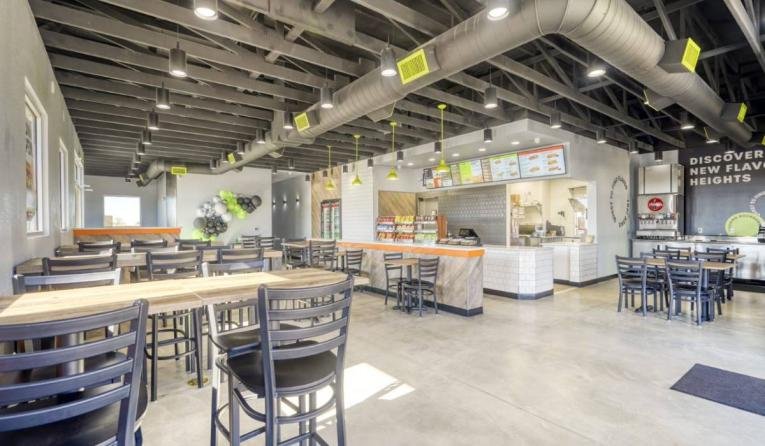5 QSR Design Trends for 2023
Photo credit: Quiznos
From self-service kiosks and digital displays, to dedicated mobile pick-up lines and “linger areas,” QSRs are tackling the fast-changing digital era head-on, with design-conscious, Instagram-worthy interiors that leverage technology and put a focus on convenience.
Here are five trends we expect to dominate QSR design for 2023 and beyond – and how you can stay ahead of the curve.
Building for Change
There is an oft-quoted belief that QSRs should refresh their interiors every three to five years, and with the rise of foodie culture, TikTok, and Instagram, the ability to change – and change fast – has never been more important. As a response, more and more QSRs are turning to modular designs and re-image projects to build spaces that facilitate change.
A re-image is a much more cost-effective way to refresh and re-organize an interior, including:
Replacing front counters, cabinets, tabletops, and seating
Updating point-of-sale software and systems
Adding digital displays and kiosks
Removing and replacing existing fixtures
Installing new flooring
Recladding
The Archmill House team has years of experience overseeing QSR re-imaging projects, like this Popeyes location in West Virginia, and can help you refresh your store with existing fixtures and furniture pieces. Get in touch today for a quote.
Creating Great Customer Experiences
Many brands have begun experimenting with their interiors to encourage return visits and provide a unique experience. McDonald’s, for example, replaced plastic finishes with natural materials. They also softened their lighting and brought in features to encourage “lingering,” such as sofas, armchairs, TVs, and family zones. Wendy’s introduced faux wood flooring and communal tables and sinks to provide a friendlier, community-focused experience.
But creating a great customer experience can be as easy as providing separate spaces for in-person dining, delivery and pick-ups, and take-out orders, ensuring that they do not interfere with each other.
Archmill House’s Rapid Re-Image program has helped many QSRs redesign their space to create a better customer experience. Contact us today for a no-obligation quote.
Embracing Technology
Many QSRs have begun incorporating smart tech in-stores, including smart appliances, order kiosks, and digital menu boards. Panera, for example, has implemented digital screens for drive-through and in-store menus, and linked these to loyalty programs, allowing customers to access recent orders and favorites.
Self-service kiosks have also been one of the most in-demand upgrades, allowing customers to browse menus, order food, and pay without having to interact with a cashier. Apart from streamlining the order process – and allowing staff to receive details in real time – these kiosks also help upsell products and improve customer experience. Wendy’s restaurants with self-service kiosks reported higher satisfaction ratings than those without.
Similarly, kitchen display systems are an increasingly common upgrade, making open orders viewable as they come in and reducing ticket times by as much as 40%.
Personalize Online and Mobile Ordering
According to Research and Markets, online delivery is expected to be worth $154.34 billion by 2023. CBRE, meanwhile, reports that revenue from app-based food orders is expected to increase 62% by 2025.
QSRs that best leverage the demand are those that personalize the online and mobile ordering experience, allowing customers to create a profile on your website or app, add favorite items or orders, and get special offers and discounts.
Starbucks and Dunkin’ Donuts are two brands that have done well in this area, letting mobile users create savable, custom orders that can be saved for rapid re-ordering and pick-up.
Putting Convenience First
According to a study by Oracle, 58% of consumers say they are more inclined to pick a restaurant offering curbside pickup. The QSRs that have best capitalized on this demand are those that have removed any potential obstacles, including:
Allowing space in the parking lot for curbside pickup
Replacing signage and wayfinding to let customers know where to go
Updating websites, apps, and POS systems to make ordering processes clear
Dunkin’ Donuts and Wendy’s are two good examples, as both have also allowed customers to pick up food in drive-through lanes.
If you don’t have a drive-through lane, consider walk-up order windows. Shake Shack has added these to 40% of its stores, appealing to customers that don’t want to dine in, but don’t want delivery either.
Food lockers are another recent addition that have proven popular with QSRs like Burger King, KFC, and Smashburger, helping them weather labor shortages and maintain quality while simplifying food collection.
Re-imaging is an easy way to freshen up your interior and put the customer first. Archmill House’s Rapid Re-Image program lets you update your establishment without the cost and delays of a full renovation. See what we did for the flagship Psycho Bunny location in Toronto and get in touch today for a quote.



